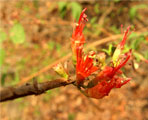



The flowers are flame coloured, hence the name, and yield a red dye used to colour fabric. It has been used medicinally for centuries.
It is found commonly throughout India, Sri Lanka and other Asian countries and is widely cultivated as an ornamental shrub.
A much-branched, leafy shrub with fluted stems and long, spreading branches (Plate 69). It usually reaches about 3 m in height or, more rarely, up to 7 m. The smooth, reddish?brown bark peels off in thin fibrous strips. Leaves Ian ceo late, oblong or ovate?lanceolate; flowers numerous, brilliant red in dense axillary paniculate-cymose clusters. The capsules are ellipsoid and membranous, containing the minute, brown, smooth seeds.
Flowers.
The flowers are stimulant and astringent and an infusion of the flowers and leaves is used as a herbal tea. The flowers are added to prepared liq uids to make many of the aristas and asavas by alcoholic fermentation, before the pots are sealed and stored. Powdered dried flowers in curdled milk are used in the treatment of dysentery, diarrhoea and internal haemorrhages and, with honey, are given for leucorrhoea and menorrhagia. Externally, the powder is sprinkled over foul ulcers and wounds to diminish discharge and promote granulation, and used in lotions for the same purpose. Dried flowers are useful in disorders of the mucous membranes, haemorrhoids and disorders of the liver.
Flower and root used in the treatment of rheumatism, dysentery, foot and mouth disease, lumbar and rib fracture.
The flowers contain the hydrolysable tannins oenothein A and B, woodfordins A-I and isoschimawalin A.
The flowers contain pelargonidin-3,5, diglucoside, cyanidin-3,5, diglucoside and the leaves contain numerous quercetin and myricetin glycosides.
The flowers contain octacosanol and ?sitosterol.
Chrysphanol-8-0-?- D-glucopyranoside has been isolated from the flowers.
Antiinflammatory and antipyretic activity: A water extract of the flowers exhibited antiinflammatory activity against cotton pellet-induced granuloma in rats. Tissue granuloma formation was prevented but no effect on adrenal ascorbic acid was observed. The ethanolic extract also showed significant antiinflammatory and antipyretic activity, at a dose of 500 mg/kg.
Antitumour activity: Woodfordin C, isolated from the dried flowers of Woodfordia fruticosa, prolonged the lifespan of mice inoculated with sarcoma 180 cells by 160%. One of the five mice survived to the 60th day at a dose of 10 mglkg. The in vitro and in vivo antitumour activity of woodford in C compared favourably with the topoisomerase- II inhibitors adriamycin and etoposide. Woodfordin C strongly inhibited intracellular DNA synthesis but not RNA and protein synthesis and showed remarkable activity against PC-l cells although only moderate activity against MKN45 and KB cells. Furthermore, woodfordin C had in vivo inhibitory activity against the growth of inoculated colon 38 cells, suggesting that the mechanism by which woodfordin C exhibits antitumour activity may be through inhibition of topoisomerase- II.
Antiviral activity: Methanolic and aqueous extracts of the flowers and leaves inhibited avian myeloblastosis virus reverse transcriptase (RT). No cytotoxicity was observed in the extracts even at concentrations where there was over 90% inhibition of RT activity.
Immunomodulatory activity: The contribution of Woodfordia fruticosa flowers to the immunomodulatory activity of the Ayurvedic drug Nimba arishta was investigated and the preparation was found to inhibit both human complement activity and chemiluminescence generated by zymosan-stimulated human polymorphonuclear leucocytes. It was established that the increased biological activity was not due to microbial interference, but to immunoactive constituents released from the Woodfordia flowers.
The 50% ethanolic extract of the whole plant had a maximum tolerated dose of 100 mg/kg body weight in rats.
Copyright © Krishna Herbal Company 2022. All Rights Reserved Powered By: Planet Ayurveda







